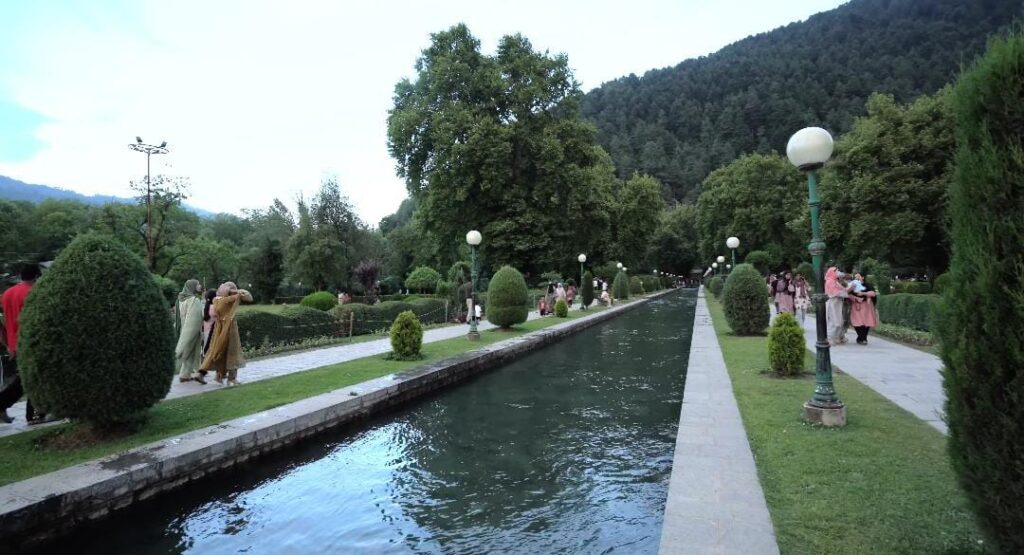
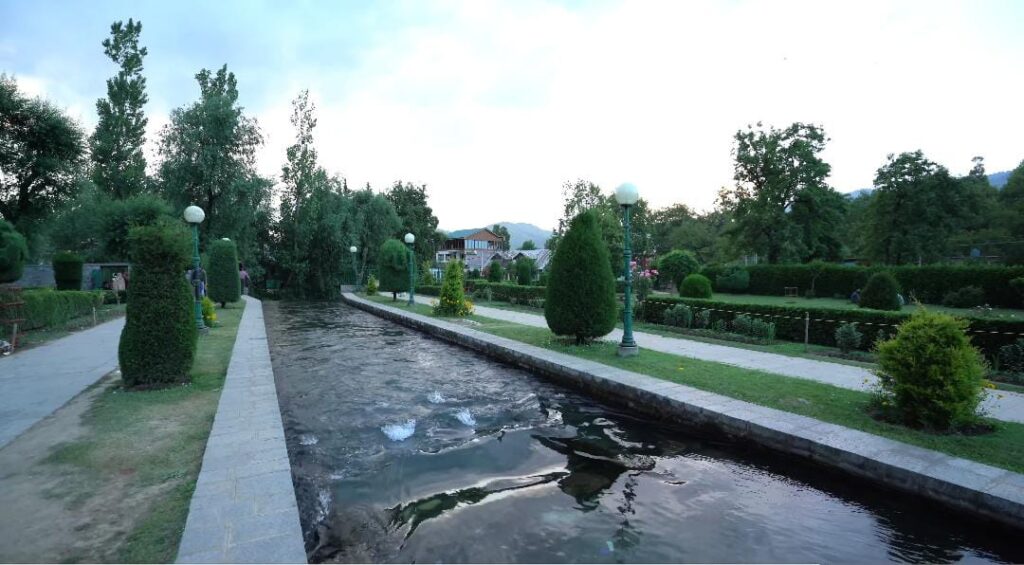
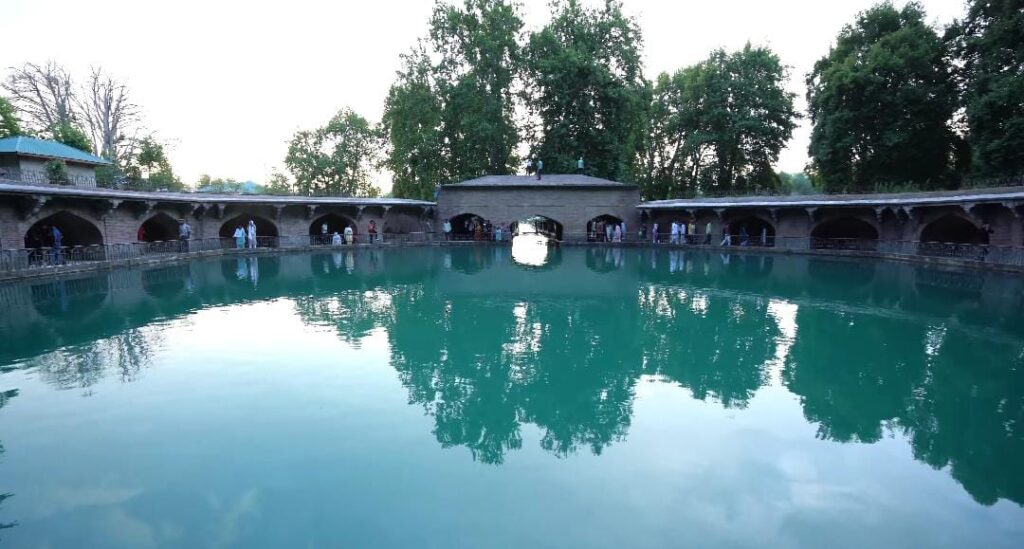
verinag spring
Verinag is a town in Anantnag district of Jammu and Kashmir. It is located at a distance of 26 kilometers from Anantnag town and approximately 78 kilometers from Srinagar, the summer capital of Jammu and Kashmir. it is also the first tourist spot of Kashmir Valley when traveling by road from Jammu, the winter capital of Jammu and Kashmir towards Srinagar.
It is a popular tourist destination due to its scenic beauty and religious significance. It is home to a large spring, which is considered to be the source of the Jhelum River. The spring is surrounded by a beautiful garden, which was laid out by the Mughal emperor Shah Jahan in the 17th century.
It’s famous for its beautiful spring, which is like a natural fountain. This spring is important because it’s where a big river called Jhelum starts. Today, it is a popular spot for tourists. People go there to see the pretty spring, explore the Mughal garden, and enjoy the peaceful surroundings. There are also almond and walnut orchards nearby, which add to the charm of the place.
Whether you like history, nature, or just want a break from busy city life, it has something for everyone. It’s a place where the past and the present come together to create a special experience.
The history of Verinag
Verinag has a very old and interesting history that goes back a really long time. It’s mentioned in ancient Hindu stories like the Mahabharata, where it’s said that the Pandavas, who were important characters in the story, stayed here during their exile.
In a book called the Rajatarangini, written by a Kashmiri historian named Kalhana in the 12th century, Verinag is also talked about. Kalhana said that Verinag used to be a famous place for religious pilgrims a long time ago. There was even a big Buddhist monastery there at one point.
Around the 11th century, a king named Anantadeva from Kashmir built a temple in Verinag dedicated to a god called Nilanaga.
The Mughal emperors, who were rulers in India during the 17th century, were also charmed by Verinag. The famous emperor Jahangir made a beautiful stone pool at the Verinag Spring, and his son Shah Jahan created a lovely garden nearby.
It was also a center of education and culture. In the 18th century, a scholar named Pandit Sahab Kaul started a school there where he taught students about many different subjects, like religion, philosophy, and science.
Both Hindus and Muslims hold Verinag in high regard. Hindus believe that the spring is the home of the god Nilanaga.
These days, it is a popular place for tourists. People visit to enjoy its natural beauty, learn about the history and culture of Kashmir, and experience its spiritual importance. It’s a place where you can relax, recharge, and appreciate the past and present.
Religious significance of Verinag
Hindus believe that the spring is home to the god Nilanaga, who is a manifestation of the Hindu god Shiva. Hindus also believe that the spring is the source of the Jhelum River, which is considered to be a holy river.
Both Hindus and Muslims make pilgrimages to Verinag throughout the year. The most important Hindu festival celebrated at Verinag is the Nilamata Jayanti, which is celebrated on the birthday of the goddess Nilamata, who is the consort of the god Nilanaga. The most important Muslim festival celebrated at Verinag is the Shab-e-Barat, which is a night of forgiveness and blessings.
It is also a place where Hindus and Muslims live together in harmony. The town has a Hindu temple and a Muslim mosque, which are located next to each other. Hindus and Muslims often visit each other’s places of worship and participate in each other’s festivals.
It is a place of great religious significance for both Hindus and Muslims. It is a place where people of different faiths come together to worship and pray. It is also a place where people of different faiths live together in harmony and respect for each other.
Things to do in Verinag
The natural beauty of Verinag is truly captivating, making it a popular destination for nature lovers and tourists. Here’s a glimpse of the breathtaking natural beauty you can find in Verinag:
Verinag Spring: The centerpiece of Verinag’s natural beauty is its pristine spring. The Verinag Spring is renowned for its crystal-clear waters, which gush forth from the foothills of the surrounding mountains. The sight of the spring, with its shimmering waters, is a treat for the eyes and a source of tranquility.
Surrounding Mountains: Verinag is nestled in the foothills of the Himalayan Mountains, which provide a stunning backdrop to the region. The lush greenery, particularly during the spring and summer seasons, contrasts beautifully with the snow-capped peaks in the distance.
Flora and Fauna: The region around Verinag is rich in biodiversity. You can find a variety of native plant species, including almond and walnut trees. Birdwatchers can spot numerous avian species, adding to the area’s charm.
Mughal Gardens: The Mughal garden created by Emperor Jahangir and later enhanced by Shah Jahan is not only a historical gem but also a showcase of natural beauty. The well-maintained gardens feature meticulously laid out flowerbeds, terraced lawns, and fountains, all set against the backdrop of the Verinag Spring.
Seasonal Changes: experiences distinct seasons, each with its own charm. Spring brings blooming flowers and a vibrant landscape, while summers offer pleasant weather for exploration. In the fall, the foliage turns into a riot of colors, making it a picturesque setting. Winters, with their snow-covered landscapes, add a touch of magic to the region.
Serene Atmosphere: One of the most beautiful aspects of Verinag is its serene and peaceful atmosphere. The gentle sounds of flowing water, the chirping of birds, and the rustling of leaves create a soothing ambiance, perfect for relaxation and meditation.
Streams and Waterfalls: Besides the Verinag Spring, the region is dotted with streams and small waterfalls. These natural water features enhance the overall beauty of the area and provide opportunities for leisurely walks and picnics.
Paddy Fields: The valley around Verinag is known for its lush paddy fields, which add a touch of green to the landscape. These fields are not only visually pleasing but also crucial to the local agricultural economy.
Tips for visiting Verinag
Visiting Verinag can be a delightful experience, but it’s essential to plan your trip carefully, especially given its location in the region of Jammu and Kashmir. Here are some tips to ensure a safe and enjoyable visit to Verinag:
Check Travel Advisories: Before planning your trip, check for any travel advisories or restrictions in the region. Political and security situations can change, so it’s crucial to stay informed about the current conditions in Jammu and Kashmir.
Weather Considerations: Verinag experiences distinct seasons, so pack accordingly. Summers (May to September) are pleasant, while winters (November to February) can be quite cold with snowfall. Dress in layers and bring warm clothing if visiting during the colder months.
Acclimatization: If you are traveling to Verinag from a lower altitude, it’s advisable to acclimatize slowly to prevent altitude sickness. Spend a day or two in Srinagar or a nearby town to adjust to the higher altitude.
Travel Documents: Ensure you have all the necessary travel documents, including permits if required for the region. Check in advance if there are any specific entry requirements for non-residents.
Accommodation: Book your accommodation in advance, especially during the peak tourist season. Verinag offers a range of options, including hotels, guesthouses, and even homestays where you can experience local hospitality.
Local Cuisine: Try the local Kashmiri cuisine. Kashmiri cuisine is known for its aromatic flavors and includes dishes like Rogan Josh, Dum Aloo, and various types of kebabs. Don’t forget to taste some Kashmiri tea (Kahwa).
Transportation: Plan your transportation in advance. You can hire a taxi or use local transport to reach Verinag from nearby cities like Srinagar. Roads may be narrow and winding, so be prepared for the journey.
Photography: It offers breathtaking scenery, so don’t forget your camera or smartphone for capturing the beautiful landscapes. Be respectful when taking photos, especially at religious sites and with locals.
Respect Local Culture: Jammu and Kashmir have a rich cultural heritage. Show consideration for the local customs and traditions, and opt for modest clothing, particularly when visiting religious sites.
Safety: Keep an eye on the local news and follow any safety instructions from local authorities during your visit. Stay in well-traveled areas and avoid venturing into remote or potentially unsafe regions.
Language: While many people in Verinag can communicate in Hindi or English, learning a few basic Kashmiri phrases or greetings can go a long way in connecting with the locals.
Travel Insurance: Consider purchasing travel insurance that covers unexpected events, including medical emergencies and trip cancellations.
Best Season to visit Verinag
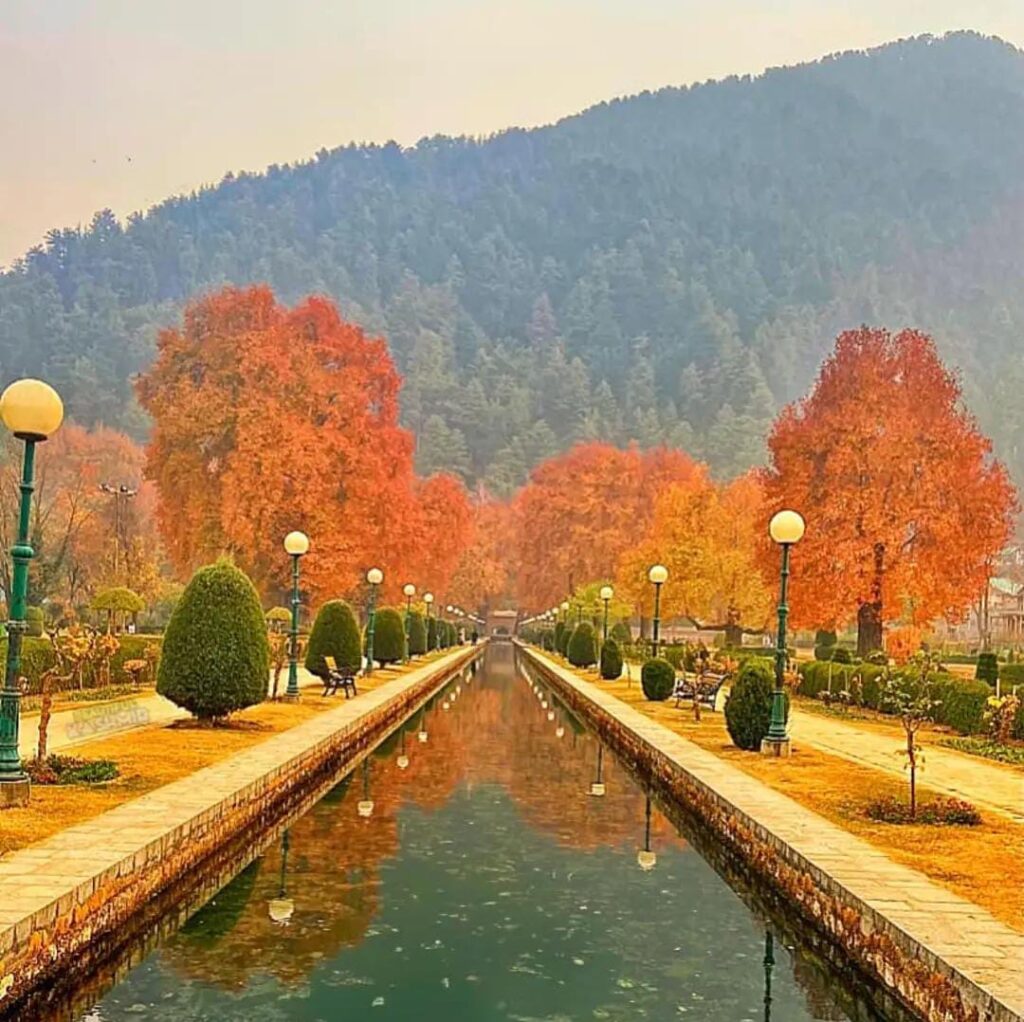
Summer (March to June)
Summer is the peak tourist season in Verinag, as the weather is pleasant and sunny, with average temperatures ranging from 15 to 25 degrees Celsius. The Mughal Garden is in full bloom during this time, and the surrounding countryside is lush and green. However, it can also get quite crowded during the summer months, so it is advisable to book your accommodation and transportation in advance.
Monsoon (July to September)
The monsoon season in Verinag lasts from July to September, and the area receives heavy rainfall during this time. This can make it difficult to get around and enjoy the outdoors, so it is not the best time to visit if you are looking for a sunny and dry vacation. However, the monsoon rains also add to the beauty of the region, and the waterfalls and rivers are at their most scenic during this time.
Autumn (October to November)
Autumn is a great time to visit Verinag, as the weather is mild and sunny, and the crowds have thinned out. The Mughal Garden is still beautiful during this time, and the leaves on the trees change color, creating a stunning landscape.
Winter (December to February)
Winter is the coldest time of year in Verinag, with average temperatures ranging from 0 to 10 degrees Celsius. The Mughal Garden is closed during this time, and there is a chance of snowfall. However, Verinag can be a beautiful place to visit during the winter, and there are a number of winter sports activities available in the nearby area.
Overall, the best time to visit Verinag depends on your personal preferences. If you are looking for pleasant weather and beautiful scenery, then spring and autumn are the best times to visit. If you are interested in winter sports, then winter can also be a good time to visit. However, it is important to note that the Mughal Garden is closed during the winter months.
Conclusion
Verinag is a very beautiful and historically important place in the pretty region of Jammu and Kashmir. It’s special because of its natural beauty, especially the clear Verinag Spring and the nearby Himalayan mountains, making it a great spot for people who love nature and want a peaceful getaway.
Verinag has a really old history that goes back to old times. Hindu stories and Kashmiri historians have talked about it. It’s important in India’s culture and religion. The Mughal kings like Jahangir and Shah Jahan thought it was beautiful and made lovely Mughal gardens there. People still love to visit these gardens.
iT isn’t just a place to see nice things, it’s also special for Hindus and Muslims. They find it important for their beliefs, which makes it even more interesting.
When you go to Verinag, make sure you know about the current travel conditions, choose the right time of the year to visit, and be respectful to the local customs. Whether you like nature, history, or spirituality, Verinag has something special for everyone. It’s a great example of how history, nature, and faith can all exist together in Jammu and Kashmir.
Frequently question about apharwat peak gulmarg
What is Verinag?
Verinag is a majestic natural spring located in the Anantnag district of Jammu and Kashmir, India. It’s considered one of the largest freshwater springs in India and the source of the Jhelum River, the lifeline of Kashmir.
Where is Verinag located?
Verinag is situated about 22 km south of Anantnag town and 78 km from Srinagar, nestled amidst the Pir Panjal mountain range.
What is the historical significance of Verinag?
Verinag has been revered for centuries. Mughal emperors established gardens around the spring, and it finds mention in the ancient epic poem Rajtarangini.
What is the best time to visit Verinag?
Spring (March-May) and Autumn (September-November) offer pleasant weather with vibrant scenery. Summers can be warm, while winters bring a snowy wonderland experience.
How to reach Verinag?
You can reach Verinag by road from Srinagar or Anantnag. Taxis and local buses are easily available.
What are things to do at Verinag?
Witnessing the cascading spring waters, exploring the Mughal gardens, picnicking amidst nature, boating on the spring (seasonally available), and enjoying local cuisine are popular activities.
Is there accommodation near Verinag?
Limited accommodation options are available near the spring, including guesthouses and homestays. Alternatively, you can stay in Anantnag or Srinagar.
Is there an entry fee for Verinag?
Yes, there is a nominal entry fee for visiting the spring and gardens.
Are there any restaurants or cafes near Verinag?
A few basic eateries offer snacks and drinks. For wider options, consider Anantnag or Srinagar.
Is Verinag safe to visit?
Generally, yes. However, as with any travel destination, check the latest travel advisories and exercise caution.
Discover the Magic of Kashmir’s Natural Beauty in Our New Blog – An Adventure You Can’t Miss! Gulmarg , Dal Lake , Pahalgam , Tulip Garden , Doodhpathri Kashmir
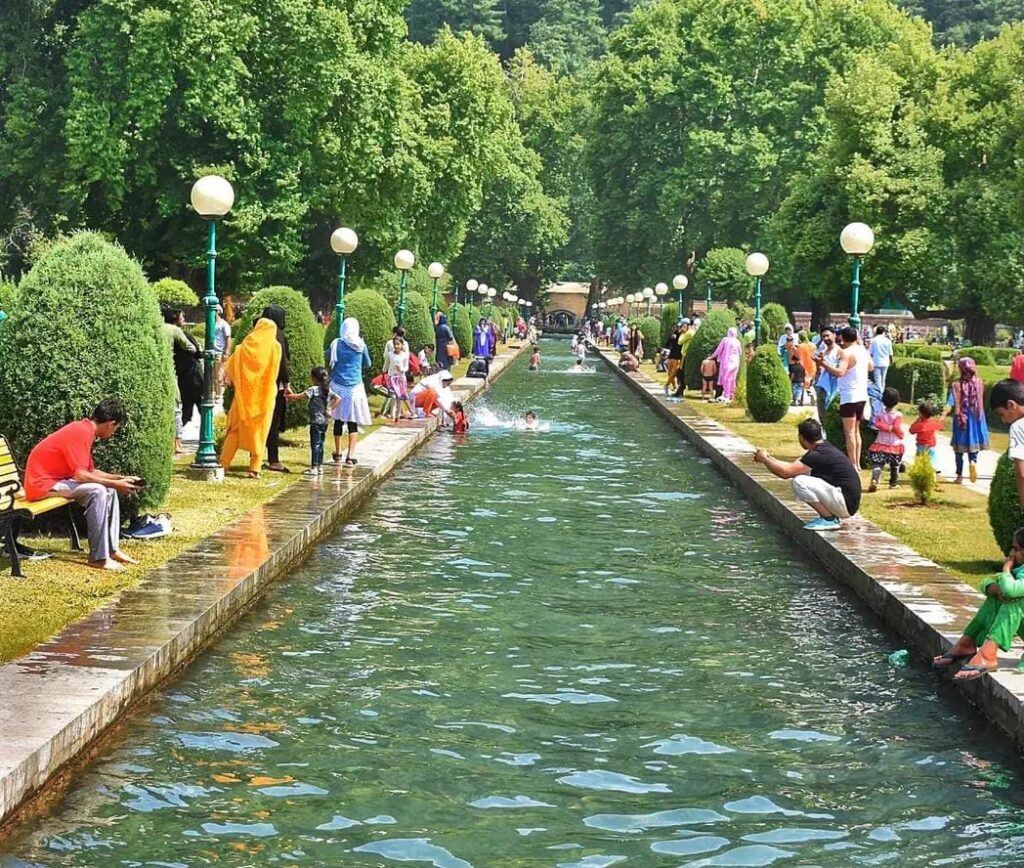
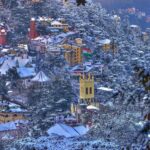
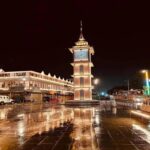


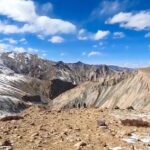

Well explained…. thanks alot..